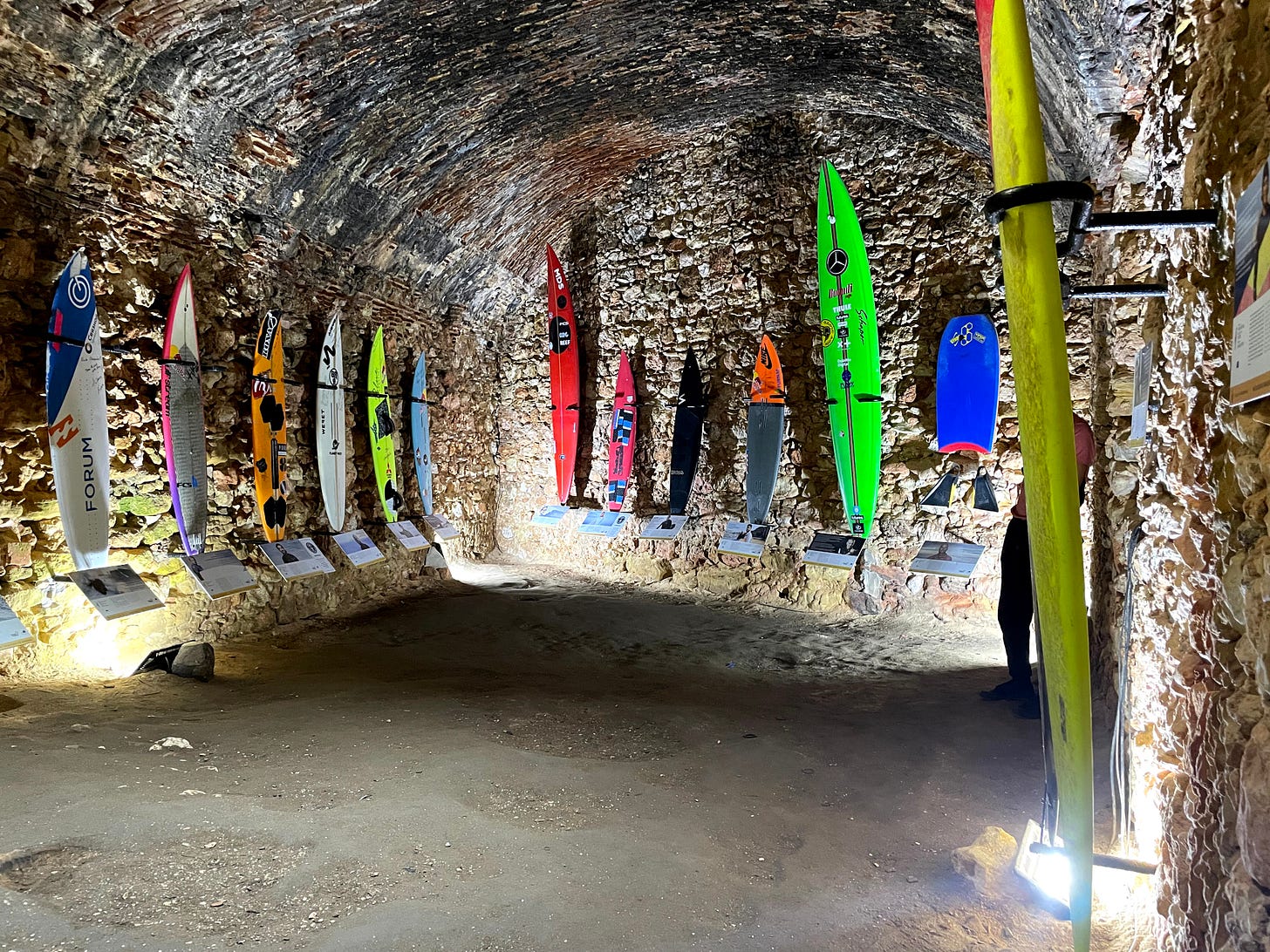Once a sleepy little fishing village, with a legend involving a deer, now Nazaré boasts the most prestigious big surf contest in Europe…perhaps the world. It is because of an undersea canyon that terminates at Praia do Norte.
Fort of São Miguel Arcanjo
After visiting Santuário de Nossa Senhora da Nazaré, we made our way to what was once a fort. Surrounded by the sea on three sides, the Fort of São Miguel Arcanjo is built on the cliffs and provides a perfect viewing spot for the annual surfing competition. Originally constructed under the orders of King Sebastian I in 1577, the fort has been expanded and upgraded over the years. One interesting, fun fact related to the fort is that it was occupied in 1807 by a detachment of 50 Frenchmen when all the fort’s artillery had been moved to Cascais to better protect Lisbon. A group of students convinced the French that reinforcements had been received and this caused them to surrender and be imprisoned in the fort. Unfortunately, more French came later and burnt down most of the town, and killed the inhabitants in reprisal for the ruse.
The fort was recommissioned as a lighthouse in 1903. Now it is a museum that focuses on surfing and the unique typology the causes these big waves. One room within the museum provides a scale model, informative videos, and placards describing the undersea canyon. We learned that at a depth of 5,000 meters (more than 3 miles) and 230 kilometers (140 miles) from the beach this is the largest submarine canyon in Europe. While the Grand Canyon is much larger, it is only 1/3 as deep. As I read about the three distinct sections of the canyon and the fact that one falls along the edge of the continental shelf I was reminded that we left one earthquake-prone area for another. (I had said I wasn’t going to do that…but I digress.)
The Making of a Monster Wave
We learned you can’t have waves without winds. (Well that is not entirely true. You could have an earthquake…but let’s not go there.) In this scenario, winds come off the north, perhaps from storms as far away as Greenland or Canada. As messy, disorganized waves cross the ocean they become “swell”. (I am now reminded of the messy gathering of winds off the coast of Africa that formed hurricanes that battered our Florida coastal homes…again, I digress.)
But waves don’t just exist on the surface of the water. They are affected by what is below…the seafloor.
This is what happens at Nazaré to create giant waves. Extending out to sea from the shore is an underwater canyon that was etched out by an ancient river when past sea level was much lower than it is today. As waves propagate toward shore over this canyon, it acts like a magnifying glass and refracts the waves toward the center of the canyon. This focusing of waves by the Nazaré Canyon helps make the largest surfable waves on the planet. — Brandeis.edu
Tow In Surfing
While Peniche and Ericeira were attractive Portuguese surfing destinations, Nazaré was a latecomer to the party. You see, the waves are so large in Nazaré that one could not paddle out to or on to them. It wasn’t until the late 90’s that someone in Hawaii figured out how to use a Jetski to tow a surfer onto the wave. But this approach was controversial and it was not until an American surfer who didn’t even know where Portugal was, explored the option:
McNamara didn’t especially care that tow-in surfing wasn’t in vogue. He heard about Nazaré for the first time in 2005 when he received an email out of the blue from Dino Casimiro, a local bodyboarder and sports teacher. Casimiro admits that he tried to contact every big-wave surfer he’d ever heard of, but McNamara was the only one who had a website and email address. McNamara didn’t bite immediately, in part because he wasn’t totally sure where Casimiro was talking about. “To be honest, as an average American, one who got his education in the ocean, I didn’t know where Portugal was,” he admits. — The Guardian
It turns out it took until 2010 for McNamara, now the unofficial mayor of Nazaré, to take on the big waves and set a Guinness World Record riding a wave measuring 23.77 meters (78 feet). The record was broken in 2017, by the Brazilian Rodrigo Koxa at 24.38 meters (80 feet). Most believe that there is a 100 feet wave to be surfed.
Each year “extreme surfers” gather in Nazaré from November to March in hopes of conquering “Big Mama”, the Everest of Waves. If you aren’t up to participating, take time to watch this video instead:







I find the 'recycling' of buildings in European countries fascinating and inspiring. First a fort, then a lighthouse, etc. It happens a lot in Amsterdam too. Castles and forts are not so necessary these days. Great stuff.
The 60 Minute segment is incredible. Thanks for posting. Not many extreme sports compare to the danger of these waves.